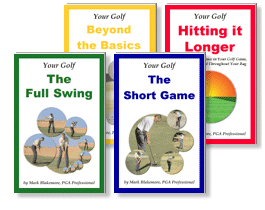Golf Instruction Article |
|||||
What Does That Mean?
|
|
Work on your game in person with the author of this article and website at Located in the east bay area of San Francisco Or if that's not possible get the author's 4-volume series of paperback books covering the entire game in detail. |
Golf lingo is something that you pick up over time, just by being around the game. But there are some terms or phrases thrown about that might be confusing until you get used to them. I learned most of these things as a junior player, so it is easy for me to take it all for granted now. But here are some clarifications on some things that people tend to wonder about and that I am asked about from time to time. I'm not basing this on any authoritative golf history or lexicon -- there may not even be any for this kind of stuff -- it's just how I absorbed it in the process.
Choking up, choking down (altering hand position up or down on the grip)
My first experience with the phrase "choke up" came at about age 9, in organized recreational baseball. It seems pretty clear that on a baseball bat (which is generally upright in a player's ready position) the "bottom" is the handle, or grip end, and the "top" is the meat or wide end. Therefore, if you wanted to make the length of the bat or lever shorter you would choke up (move your hands more toward the top).
But on a golf club, you'd probably think of the grip as the top and the club head as the bottom. Therefore the same idea, shortening the length, might be more intuitively thought of as choking down, rather than up. But it's the same thing. Whether you call it choking up or choking down it means moving your hands to make the lever shorter.
Inside the leather
This is an old expression referring to putters and how close the ball is to the hole -- whether or not it is close enough to be "a gimme" (conceded as holed without actually going to the trouble of putting it in) in casual play.
The word inside tends to mean closer than and outside farther than. So inside the leather would mean closer than the the leather. Ah, but from which end? Many people ask, "Does that mean from the top end of the grip to where the shaft starts or from the club head to where the grip starts?" It means the latter. Inside the leather is generally thought of as the ball being less than (inside) the distance from the club head to where the grip* starts and it is typically measured by hooking the end of the putter in the lip of the cup, similarly to if you were hooking the tab of a tape measure on the lip. (It's probably best not to do this, and I recommend against it. But if you do be gentle, and very careful not to chew up the edge of the cup or any of the green's surface!)
Of course, unless everybody is using the same length putter as a measuring device this is an inequitable practice anyway. Can't you just see somebody with one of those long putters trying this? ![]()
Club up, club down
The easiest way to differentiate clubbing "up" from clubbing "down" is to think about it in terms of the distance that the club provides. If you wanted to club up from a 7 iron the next step would be a 6 iron, as it provides more distance than (is up from) a 7. You could get confused if you thought of it in terms of the club's number (i.e., a 7 is up from a 6 in that sense). Clubbing up could also be referred to as taking "more club" or using a "stronger" club, as clubbing down could be referred to as taking "less club" or using a "weaker" club.
Why would you want to club up or down? Take the simple example of playing into the wind. Let's say you are 150 yards away and normally from that distance you would hit a 7 iron. But the wind is blowing toward you, so your 7 iron will not travel its
usual distance. You need to club up (choose a club that provides more distance to compensate for the wind), perhaps to a 6 iron. But wait, what if it is a "three-club wind?" Here's an opportunity for us to clarify another idea. Pretty
simple really: however strong the wind is, there is an appropriate adjustment to make in terms of how much you club up or down... well, until the wind gets so strong that you give up and head back in to the clubhouse. So if
we have a three-club wind it means that the adjustment we'll need to make in order to get the right distance will be three clubs, or say from a 7 to a 4, if you're playing into the wind - that's a pretty substantial wind. ![]() How much you need to club up or down in any given situation varies from player to player, like a lot of other things, and is something you learn from your experience.
How much you need to club up or down in any given situation varies from player to player, like a lot of other things, and is something you learn from your experience.
OUT/IN, front/back, first/second
On many, if not most, scorecards you see boxes for your 9-hole score total labeled OUT and IN. Sometimes people wonder what that's about. The deal here is pretty obvious, once you realize that "the home of golf," St. Andrews in Scotland (where the whole "18 holes" thing originated) was laid out in such a way that the first 9 holes of the course went "out" (away from) where the first hole started and kept going farther away until "the turn," and then the second 9 holes came back "in" to the place where the course began. That's a pretty simple way to lay out a golf course, don't you think?
Most golf courses are not made that way nowadays, but there are some. Pebble Beach is one notable example. When courses are not designed that way they most typically go out away from and return to the clubhouse on each 9 holes, so in most cases front/back nine or first/second nine makes more sense than out/in, but it may still say out and in on the score card - just another of those traditional things that adds flavor to the game.
Up to par?
Under par is actually good... isn't it? On a given day your golf performance might be sub par (worse than your usual) even though your score was above par. So then you would be over par, but not up to par, and certainly not better than par. Right? [chuckle] On the other hand, you could be not feeling up to par, even though your score was under par. You'd be sub par in both senses, in that case, but would you be happy about it?
Okay, enough. To be clear, then, if you're talking about your score "sub par", "under par" or "below par" are all GOOD. But if you are talking about your health, the way you feel, or your swing or stroke being below par that is NOT good, as it means you are not doing as well as you usually do.
It's interesting to see what the dictionary has to say about par (excerpt from Webster)
- the established value of the monetary unit of one country expressed in terms of the monetary unit of another country using the same metal as the standard of value
- common level, equality
- a. an amount taken as an average or norm
b. an accepted standard; e.g., a usual standard of physical condition or health - the score standard for each hole of a golf course
We're mainly discussing definitions 3 and 4 above. But it is important for golfers to realize that number 4 leaves out a critical distinction. Par is mistake-free play for a scratch golfer. So the score standard is not based on average golfers, but on highly skilled golfers.
There certainly may be other (maybe many other) ambiguous terms or phrases in golf. If you know of any others , and if I get enough I will either update this article or post another one. And don't forget to check my golf glossary, too. It has over 800 golf words and phrases in it.
* Grips used to be made of leather - and, in fact, some still are
![]()
 |
 |
Work on any part of your game with PGA professional Mark Blakemore, author of this website, in person at two locations in the east bay area of San Francisco. Or get the books...
Related Content
Golf Glossary - almost 700 golf words and phrasesAsk the Pro - entries on terminology and much more
Golf Instruction (in-person) - Private Golf Schools
Golf Instruction Book - "Your Golf" series
Golf Instruction Articles - various
For more golf instruction articles see my
archive of previous golf instruction articles.
Feel free to send me a message to suggest a topic for future articles.


